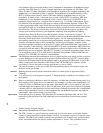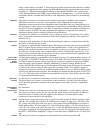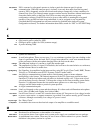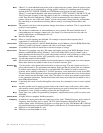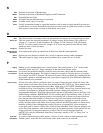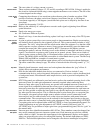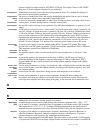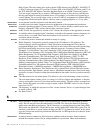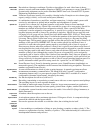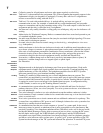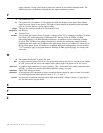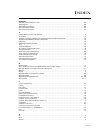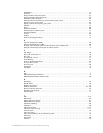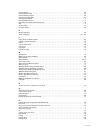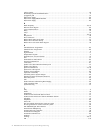Glossary147
include compounds. Some examples are semiconductor diodes, transistors, integrated circuits,
transector overvoltage devices, thyristors, and carbonized substances.
Sensitivity
1. The electrical output of a microphone for a given SPL input. Open circuit sensitivity is the
output voltage a microphone produces (in dB relative to 1 volt) into an open-circuit load, at a
sound pressure of 74 dB SPL (1 microbar or 0.1 pascal). In practice, this is hard to do because of
ambient noise, so readings are taken at 94 dB and the calculation adjusted accordingly. 2. Defined
as the on-axis sound pressure level at a distance 1 meter in front of a speaker driven by 1 watt
continuous average input power of a specified waveform. 3. Defined for headsets to indicate the
SPL generated for a given set of conditions. The Beyer DT 108 headphone has a sensitivity of 94
dB SPL produced for one milliwatt input. The Telex® PH10 headphone has a sensitivity of 105
dB SPL produced for one milliwatt input. A Telex® EMV -2 announcer earset has a sensitivity of
120 dB.
Series Circuit
An arrangement of circuit elements, circuits, devices or systems such that the components are
arranged and connected end to end to form a single current path.
Shield
An electrostatic shield prevents crosstalk from one conductor to another by blocking the electric
field. For example: by shielding wires in a cable, crosstalk can be dramatically reduced. A
magnetic shield prevents electromagnetic coupling of undesired signals from one transformer to
another. For example: the magnetic field from a power transformer to an audio output transformer
can be attenuated by mu metal shielding.
Shotgun
Microphone
A highly directional microphone for long distance pickup. Looks like a shotgun.
Sidetone
In the truest sense, sidetone is a small amount of microphone signal that is fed back to the
earphone of the individual speaking into the microphone. In RTS™ TW user stations, the null
balance control is sometimes used to adjust the amount of sidetone the user hears. This control is
sometimes (technically erroneously) called the sidetone control. Other RTS™ TW equipment
have both null balance adjustments and a true sidetone adjustment (Models 802, 848 for
example).
Signal
The name applied to visual, audible, or electrical energy that carries information.
Signal to Noise
Ratio (S/N or
[S+N]/N)
In a given circuit, device, or system, the ratio of the Signal plus Noise to Noise. The noise spoken
of is the residual noise in the system when no signal is present. The signal is a signal at a reference
level representing typical operating conditions of the system. This ratio is usually specified across
a frequency band. The S/N ratio of a microphone is specified at a given SPL ratio. For example, a
S/N ratio of 60 dB at 94 dB SPL is considered good, 65 dB, very good, 70 dB is excellent.
Sigma
Symbol for summation, also used to indicate a summing amplifier or summing function.
Signaling
Signaling in these intercoms has several meanings. In the TW system, signaling is accomplished
by a blinking light initiated from any Call Light equipped station on that channel. Signaling is
often used to get attention such as getting someone to put their headset back on, or getting a sound
mixer person to turn down the monitor speaker and talk on the intercom. Signaling can also be
used as a visual cue. The blinking light can be used for a cue, but theatre productions often prefer
a steady light. The light coming on is a “Standby” signal. The light going from on to off is an
“Execute” signal.
Simplex
Simplex communication is one person at a time. There is only one communication channel
available and it is unidirectional at a time, usually in the direction determined by the call initiator.
An example of this is a CB or Citizens Band radio.
Single-ended
Unbalanced, using circuit common or “ground” as a return lead.
Single Channel /
Two Channel
In the RTS™ Systems TW Intercom system, most user stations are two channel. Other channel
numbers available (some optional some standard) are 1, 3, 4, 5, 6, 10, 12, 24. The term channels
usually is applied to conference style user stations. The TW system can carry two channels on a
standard microphone cable. Other systems carry one balanced channel (Telex® AudioCom®), or
one unbalanced channel (Clear-Com®, Telex® AudioCom® in unbalanced mode, HME, Theatre
Vision).
SMPTE
Society of Motion Picture and Television Engineers. An organization that (among other things)
pioneers standards used in the television industry.



